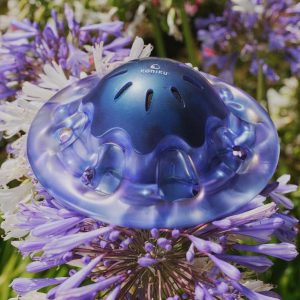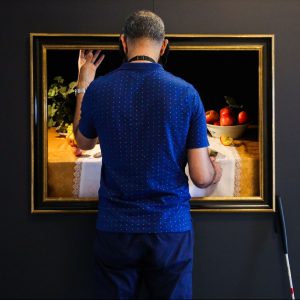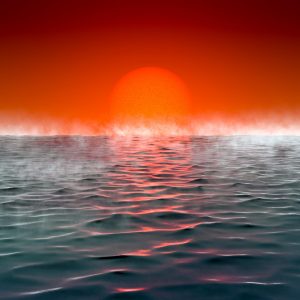Link About It: This Week’s Picks
Crochet-covered streets, “water world” planets, scent-recognizing devices and more from around the web

ONE School’s Fall Semester 2021 Applications Open
 Founded by Oriel Davis-Lyons (who has worked at Spotify, R/GA and Droga5) and The One Club for Creativity, ONE School provides free portfolio courses for Black creatives. They’re taking applications for the fall 2021 semester (two nights a week for 16 weeks) during which students—who don’t need any advertising experience—will be given 10 briefs, taught by some of the advertising world’s most successful individuals and then guided through job placement discussions. The school has an impressive 80% hire rate and, in the first year, “prepared 84 new Black creatives—65 per cent of which were women—to enter the industry.” Read more about the program and how to apply at It’s Nice That.
Founded by Oriel Davis-Lyons (who has worked at Spotify, R/GA and Droga5) and The One Club for Creativity, ONE School provides free portfolio courses for Black creatives. They’re taking applications for the fall 2021 semester (two nights a week for 16 weeks) during which students—who don’t need any advertising experience—will be given 10 briefs, taught by some of the advertising world’s most successful individuals and then guided through job placement discussions. The school has an impressive 80% hire rate and, in the first year, “prepared 84 new Black creatives—65 per cent of which were women—to enter the industry.” Read more about the program and how to apply at It’s Nice That.
Image courtesy of ONE School
Koniku’s Scent-Detecting Device
 An “iridescent purple nipple the size of a steering wheel” could be the answer to one of biotech’s trickiest problems: creating a device that successfully detects and recognizes odors. Koniku, founded and helmed by Osh Agabi, creates neurotechnology devices; one of their products is the aforementioned “purple nipple,” known as the Konikore. Within the device, living nerve cells are “suspended inside a proprietary solution designed to replicate the mucosa, the layer of membrane high up in our nasal cavities. The cells contain specific transmembrane proteins programmed to recognize odor molecules, precisely as those in our nose would catch a whiff.” The Konikore essentially signals and decodes what it smells, ultimately recognizing the specific scent. It’s already being used by the world’s biggest brewer, Anheuser-Busch InBev (owner of Budweiser, Corona, Stella Artois and others) to test drinks’ aromatics, and will soon be used in airports for bomb detection. But Koniku isn’t the only tech company exploring the olfactory world, find out more at Bloomberg.
An “iridescent purple nipple the size of a steering wheel” could be the answer to one of biotech’s trickiest problems: creating a device that successfully detects and recognizes odors. Koniku, founded and helmed by Osh Agabi, creates neurotechnology devices; one of their products is the aforementioned “purple nipple,” known as the Konikore. Within the device, living nerve cells are “suspended inside a proprietary solution designed to replicate the mucosa, the layer of membrane high up in our nasal cavities. The cells contain specific transmembrane proteins programmed to recognize odor molecules, precisely as those in our nose would catch a whiff.” The Konikore essentially signals and decodes what it smells, ultimately recognizing the specific scent. It’s already being used by the world’s biggest brewer, Anheuser-Busch InBev (owner of Budweiser, Corona, Stella Artois and others) to test drinks’ aromatics, and will soon be used in airports for bomb detection. But Koniku isn’t the only tech company exploring the olfactory world, find out more at Bloomberg.
Image courtesy of Koniku
Malaga, Spain’s Eye-Catching Crochet Sunshade
 The sun-soaked town of Alhaurín de la Torre in the province of Malaga, Spain used plastic awnings to shade pedestrians for years until the City Council’s Department of the Environment tapped local crochet teacher Eva Pacheco, and her students, to crochet colorful sunshades from recycled materials. The stunning assemblage of shifting patterns now provides shade over roughly 500 square meters. Read more about the artistic, environmental endeavor and watch a video at Core77.
The sun-soaked town of Alhaurín de la Torre in the province of Malaga, Spain used plastic awnings to shade pedestrians for years until the City Council’s Department of the Environment tapped local crochet teacher Eva Pacheco, and her students, to crochet colorful sunshades from recycled materials. The stunning assemblage of shifting patterns now provides shade over roughly 500 square meters. Read more about the artistic, environmental endeavor and watch a video at Core77.
Image courtesy of Core77
Amsterdam’s Utrecht Central Museum Hosts “The Blind Spot” Exhibit for Visually Impaired People
 Within their current exhibit, The Blind Spot, Amsterdam’s Utrecht Central Museum recreates well-known paintings with additional dimensions and sensory triggers. This is so visually impaired guests can better access and enjoy the works. For instance, the museum’s 3D version of Floris van Dyck’s “Still Life with Fruit, Nuts and Cheese” (originally from 1610) allows viewers to reach in and touch the items portrayed on the original canvas—grapes, a bread roll and cheese. Scent from the latter also contributes to the experience. Read more about the exhibition and the way it was designed at Reuters.
Within their current exhibit, The Blind Spot, Amsterdam’s Utrecht Central Museum recreates well-known paintings with additional dimensions and sensory triggers. This is so visually impaired guests can better access and enjoy the works. For instance, the museum’s 3D version of Floris van Dyck’s “Still Life with Fruit, Nuts and Cheese” (originally from 1610) allows viewers to reach in and touch the items portrayed on the original canvas—grapes, a bread roll and cheese. Scent from the latter also contributes to the experience. Read more about the exhibition and the way it was designed at Reuters.
Image courtesy of Utrecht Central Museum
New Type of “Water World” Exoplanets Beyond Our Solar System
 The search for exoplanets has traditionally centered on those similar to Earth (of a relatively proportionate size and mass with comparable temperatures and atmospheric compositions) but scientists are now “rethinking the kinds of planets that may be habitable” and looking toward a new class known as hycean planets. Beyond our solar system these planets, akin to “mini Neptunes,” are much bigger than Earth and are believed to be habitable—meaning the search for life elsewhere in the universe could yield results sooner rather than later. Hycean planets are “hot, ocean-covered and with hydrogen-rich atmospheres,” with temperatures reaching up to 392 degrees Fahrenheit (200 degrees Celsius) and are “basically water worlds,” says Dr Nikku Madhusudhan, the lead author on University of Cambridge’s research. Find out more at The Guardian.
The search for exoplanets has traditionally centered on those similar to Earth (of a relatively proportionate size and mass with comparable temperatures and atmospheric compositions) but scientists are now “rethinking the kinds of planets that may be habitable” and looking toward a new class known as hycean planets. Beyond our solar system these planets, akin to “mini Neptunes,” are much bigger than Earth and are believed to be habitable—meaning the search for life elsewhere in the universe could yield results sooner rather than later. Hycean planets are “hot, ocean-covered and with hydrogen-rich atmospheres,” with temperatures reaching up to 392 degrees Fahrenheit (200 degrees Celsius) and are “basically water worlds,” says Dr Nikku Madhusudhan, the lead author on University of Cambridge’s research. Find out more at The Guardian.
Image courtesy of Amanda Smith/PA
Link About It is our filtered look at the web, shared daily in Link and on social media, and rounded up every Saturday morning. Hero image courtesy of Amanda Smith/PA











